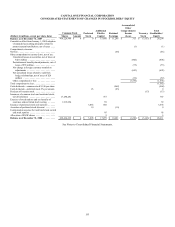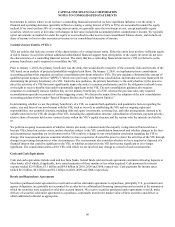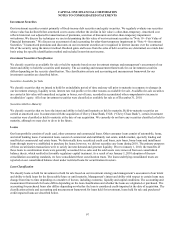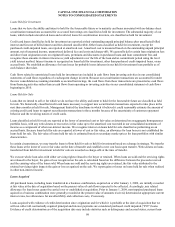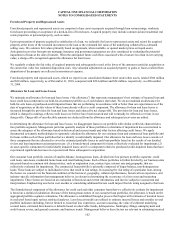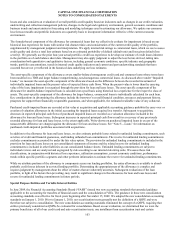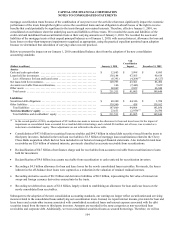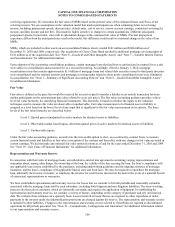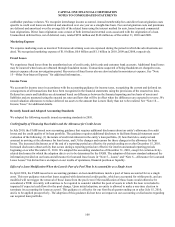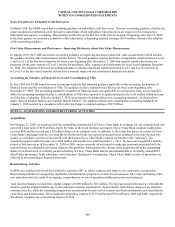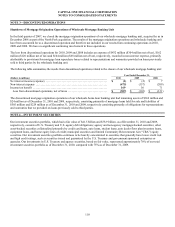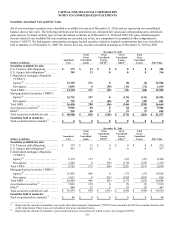Capital One 2010 Annual Report Download - page 121
Download and view the complete annual report
Please find page 121 of the 2010 Capital One annual report below. You can navigate through the pages in the report by either clicking on the pages listed below, or by using the keyword search tool below to find specific information within the annual report.CAPITAL ONE FINANCIAL CORPORATION
NOTES TO CONSOLIDATED STATEMENTS
101
• Commercial loans: Commercial loans classified as nonperforming and commercial loans that have been modified in a troubled
debt restructuring are reported as impaired.
• Purchased credit-impaired loans: We track and report PCI loans separately from other impaired loans.
We do not report nonperforming consumer loans that have not been modified in a TDR as individually impaired, as we collectively
evaluate these smaller-balance homogenous loans for impairment in accordance with applicable accounting guidance. Held for sale
loans are also not reported as impaired, as these loans are recorded at lower of cost or fair value.
All individually impaired loans are evaluated for an asset-specific allowance. Once a loan is modified in a troubled debt restructuring, the
loan is generally considered impaired until maturity regardless of whether the borrower performs under the modified terms. Although the
loan may be returned to accrual status if the criteria above under “Delinquent and Nonperforming Loans” are met, the loan would
continue to be evaluated for an asset-specific allowance for loan losses and we would continue to report the loan as impaired.
We generally measure impairment and the related asset-specific allowance for individually impaired loans based on the difference
between the recorded investment of the loan and present value of the loans’ expected future cash flows, discounted at the effective
original interest rate of the loan at the time of modification or the loan’s observable market price. If the loan is collateral dependent,
we measure impairment based upon the fair value of the underlying collateral, which we determine based on the current fair value of
the collateral less estimated selling costs, instead of discounted cash flows. Loans are identified as collateral dependent if we believe
that collateral is the sole source of repayment.
If the fair value of the loan is less than the recorded investment, we recognize impairment by establishing an allowance for the loan or
by adjusting an allowance for the impaired loan. See “Note 6—Allowance for Loan and Lease Losses” for additional information on
the asset-specific component of our allowance.
Charge-Offs
Net charge-offs consist of the unpaid principal balance of loans held for investment that we determine are uncollectible, net of
recovered amounts. We exclude accrued and unpaid finance charges and fees and fraud losses from charge-offs. Charge-offs are
recorded as a reduction to the allowance for loan and lease losses and subsequent recoveries of previously charged off amounts are
credited to the allowance for loan and lease losses. Costs incurred to recover charged-off loans are recorded as collection expense and
included in our consolidated statements of income as a component of other non-interest expense. Our charge-off time frame for loans,
which varies based on the loan type, is presented below.
• Credit card loans: We generally charge-off credit card loans when the account is 180 days past due from the statement cycle date.
Credit card loans in bankruptcy are charged-off within 30 days of receipt of a complete bankruptcy notification from the
bankruptcy court, except for U.K. credit card loans, which are charged-offs within 60 days. Credit card loans of deceased account
holders are charged-off within 60 days of receipt of notification.
• Consumer loans: We generally charge-off consumer loans at the earlier of the date when the account is a specified number of
days past due or upon repossession of the underlying collateral. Our charge-off time frame is 180 days for mortgage loans and
unsecured small business lines of credit and 120 days for auto and other non-credit card consumer loans. We calculate the charge-
off amount for mortgage loans based on the difference between our recorded investment in the loan and the fair value of the
underlying property and estimated selling costs as of the date of the charge-off. We update our home value estimates on a regular
basis and recognize additional charge-offs for declines in home values below our initial fair value and selling cost estimate at the
date mortgage loans are charged-off. Consumer loans in bankruptcy, except for auto and mortgage loans, generally are charged-
off within 40 days of receipt of notification from the bankruptcy court. Auto and mortgage loans in bankruptcy are charged-off in
the period that the loan is both 60 days or more past due and 60 days or more past the bankruptcy notification date or in the period
the loan becomes 120 days past due for auto loans and 180 days past due for mortgage loans regardless of the banruptcy
notification date. Consumer loans of deceased account holders are charged-off within 60 days of receipt of notification.
• Commercial loans: We charge-off commercial loans in the period we determine that the unpaid principal loan amounts are
uncollectible.
• Purchased credit-impaired loans: We do not record charge-offs on PCI loans that are performing in accordance with or better
than our expectations as of the date of acquisition, as the fair values of these loans already reflect a credit component. We record
charge-offs on purchased credit-impaired loans only if actual losses exceed estimated losses incorporated into the fair value
recorded at acquisition.




